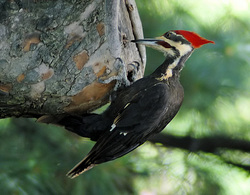Pileated Woodpecker (Dryocopus pileatus)

Description: The largest of the common North American woodpeckers by far. Nearly the size of a crow, they have been measured to be in excess of 20 inches tall. They have a very distinctive look that makes them easy to recognize from other woodpeckers. In addition to their substantial height, they have a black and white stripped head, similar to the stripping of a zebra. This is topped off with a large red crest on its head. The crest can be two or more inches long, and forms a bright red triangle coming off the birds head.
Habitat: The Pileated Woodpecker can be found throughout most of North America. Unlike other woodpeckers, they do not discriminate against certain tree types, and therefore can be found in both deciduous and coniferous forests across the continent. The Pileated Woodpecker requires substantially large trees to drill into, and so is much more common in old growth, than new growth, forests.
Diet: Like most birds, the Pileated Woodpecker eats nuts and fruits. These serve only as a supplement to its normal diet of insects. It has two main insects of choice, carpenter ants, and beetle larvae. The woodpecker acquires most of the insects it eats from trees, but has been known to scavenge the forest floor if need be.
Behaviors:
Miscellaneous:
Habitat: The Pileated Woodpecker can be found throughout most of North America. Unlike other woodpeckers, they do not discriminate against certain tree types, and therefore can be found in both deciduous and coniferous forests across the continent. The Pileated Woodpecker requires substantially large trees to drill into, and so is much more common in old growth, than new growth, forests.
Diet: Like most birds, the Pileated Woodpecker eats nuts and fruits. These serve only as a supplement to its normal diet of insects. It has two main insects of choice, carpenter ants, and beetle larvae. The woodpecker acquires most of the insects it eats from trees, but has been known to scavenge the forest floor if need be.
Behaviors:
- The most common behavior is digging a hole into a tree
- It creates a unique and perfectly rectangular hole each and every time it feeds. The construction of such a pit necessitates the bird driving its beak into the tree repeatedly.
- The bird will grab a piece of bark, which juts out from the rest of the tree, with its mouth, and pull long sheets of bark off until the soft under-wood of the tree is exposed. From there, the woodpecker will forage for ants.
Miscellaneous:
- It has been mentioned that Pileated Woodpeckers create a characteristic rectangular feeding hole. It is interesting to note how large the holes can be. Not only will sparrows and other woodpeckers come to them to eat, but they are often large enough to cause small trees to collapse.

